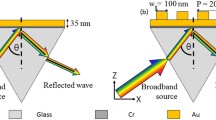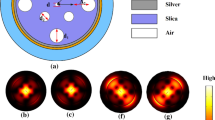Abstract
Fluid-infiltrated sculptured nematic thin films (SNTFs) were modeled using a combination of piecewise uniform approximation technique and Bruggeman formalism. The modeling was then used to exploit surface plasmon-polariton (SPP) waves for optical sensing of the fluid infiltrating the SNTF. The interface of the chosen metal and the SNTF supports multiple SPP waves of the same frequency, thereby, providing multiple angles of incidence in the prism-coupled configuration for optical sensing, offering potential for a higher confidence in measurements and multi-analyte sensing at the same time.






Similar content being viewed by others

References
Maier SA (2007) Plasmonics: Fundamentals and applications. Springer, New York, USA
Faryad M, Lakhtakia A (2010) On surface plasmon-polariton waves guided by the interface of a metal and a rugate filter with a sinusoidal refractive-index profile. J Opt Soc Am B 27:2218–2223
Abbas F, Naqvi QA, Faryad M (2014) Multiple surface plasmon-polariton waves guided by the interface of a metal and a periodically nonhomogeneous magnetic material. Opt Commun 332:109–113
Mackay TG, Lakhtakia A (2010) Modeling columnar thin films as platforms for surface-plasmonic-polaritonic optical sensing. Photon Nanostruct Fundam Appl 8:140–149
Mackay TG, Lakhtakia A (2012) Modeling chiral sculptured thin films as platforms for surface-plasmonic-polaritonic optical sensing. IEEE Sens J 12:273–280
Swiontek SE, Pulsifer DP, Lakhtakia A (2013) Optical sensing of analytes in aqueous solutions with a multiple surface-plasmon-polariton-wave platform. Sci Rep 3:1409
Faryad M, Polo JA Jr., Lakhtakia A (2010) Multiple trains of same-color surface plasmon-polaritons guided by the planer interface of a metal and a sculptured nematic thin film. Part IV: Canonical problem. J Nanophoton 4:043505
Motyka MA, Lakhtakia A (2008) Multiple trains of same-color surface plasmon-polaritons guided by the planer interface of a metal and a sculptured nematic thin film. J Nanophoton 2:021910
Motyka MA, Lakhtakia A (2009) Multiple trains of same-color surface plasmon-polaritons guided by the planer interface of a metal and a sculptured nematic thin film. Part II: Arbitrary incidence. J Nanophoton 3:033502
Lakhtakia A, Messier R (2005) Sculptured thin films: Nanoengineered morphology and optic. SPIE Press, Bellingham, WA, USA
Mackay TG, Lakhtakia A (2010) Determination of constitutive and morphological parameters of columnar thin films by inverse homogenization. J Nanophoton 4:041535
Lakhtakia A (2001) Enhancement of optical activity of chiral sculptured thin films by suitable infiltration of void regions. Optik 112:145–148
Hodgkinson I, Wu Qh, Hazel J (1998) Empirical equations for the principal refractive indices and column angle of obliquely deposited films of tantalum oxide, titanium oxide and zirconium oxide. Appl Opt 37:2653–2659
Chiadini F, Lakhtakia A (2004) Extension of Hodgkinsons model for optical characterization of columnar thin films. Microw Opt Technol Lett 42:72–73
Weiglhofer WS, Lakhtakia A, Michel B (1997) Maxwell Garnett and Bruggeman formalism for a particulate composite with bianisotropic host medium. Microw Opt Technol Lett 15:263–266
Lakhtakia A, Michel B, Weiglhofer WS (1997) The role of anisotropy in the Maxwell Garnett and Bruggeman formalisms for uniaxial particulate composite media. J Phys D: Appl Phys 30:230–240
Turbadar T (1959) Complete absorption of light by thin metal films. Proc Phys Soc 73:40–44
Kretschmann E, Raether H (1968) Radiative decay of nonradiative surface plasmons excited by light. Z Naturforsch A 23:2135–2136
Homola J (2003) Present and future of surface plasmon resonance biosensors. Anal Bioanal Chem 377:528–539
Polo JA Jr., Mackay TG, Lakhtakia A (2013) Electromagnetic surface waves. Elsevier, A modern perspective
Conflict of interests
The authors declare that they have no conflict of interest.
Funding
This study was not funded by any agency.
Author information
Authors and Affiliations
Corresponding author
Rights and permissions
About this article
Cite this article
Abbas, F., Naqvi, Q.A. & Faryad, M. Multiplasmonic Optical Sensor Using Sculptured Nematic Thin Films. Plasmonics 10, 1269–1273 (2015). https://doi.org/10.1007/s11468-015-9920-7
Received:
Accepted:
Published:
Issue Date:
DOI: https://doi.org/10.1007/s11468-015-9920-7



